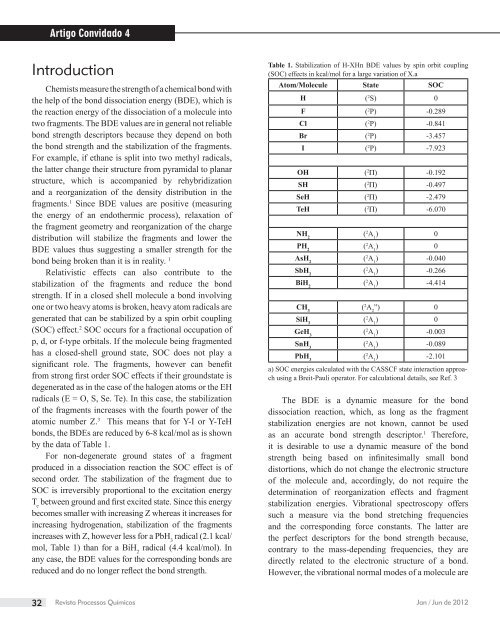Clique aqui para download - senai
Clique aqui para download - senai
Clique aqui para download - senai
You also want an ePaper? Increase the reach of your titles
YUMPU automatically turns print PDFs into web optimized ePapers that Google loves.
Introduction<br />
Chemists measure the strength of a chemical bond with<br />
the help of the bond dissociation energy (BDE), which is<br />
the reaction energy of the dissociation of a molecule into<br />
two fragments. The BDE values are in general not reliable<br />
bond strength descriptors because they depend on both<br />
the bond strength and the stabilization of the fragments.<br />
For example, if ethane is split into two methyl radicals,<br />
the latter change their structure from pyramidal to planar<br />
structure, which is accompanied by rehybridization<br />
and a reorganization of the density distribution in the<br />
fragments. 1 Since BDE values are positive (measuring<br />
the energy of an endothermic process), relaxation of<br />
the fragment geometry and reorganization of the charge<br />
distribution will stabilize the fragments and lower the<br />
BDE values thus suggesting a smaller strength for the<br />
bond being broken than it is in reality. 1<br />
Relativistic effects can also contribute to the<br />
stabilization of the fragments and reduce the bond<br />
strength. If in a closed shell molecule a bond involving<br />
one or two heavy atoms is broken, heavy atom radicals are<br />
generated that can be stabilized by a spin orbit coupling<br />
(SOC) effect. 2 SOC occurs for a fractional occupation of<br />
p, d, or f-type orbitals. If the molecule being fragmented<br />
has a closed-shell ground state, SOC does not play a<br />
signifi cant role. The fragments, however can benefi t<br />
from strong fi rst order SOC effects if their groundstate is<br />
degenerated as in the case of the halogen atoms or the EH<br />
radicals (E = O, S, Se. Te). In this case, the stabilization<br />
of the fragments increases with the fourth power of the<br />
atomic number Z. 3 This means that for Y-I or Y-TeH<br />
bonds, the BDEs are reduced by 6-8 kcal/mol as is shown<br />
by the data of Table 1.<br />
For non-degenerate ground states of a fragment<br />
produced in a dissociation reaction the SOC effect is of<br />
second order. The stabilization of the fragment due to<br />
SOC is irreversibly proportional to the excitation energy<br />
T e between ground and fi rst excited state. Since this energy<br />
becomes smaller with increasing Z whereas it increases for<br />
increasing hydrogenation, stabilization of the fragments<br />
increases with Z, however less for a PbH 3 radical (2.1 kcal/<br />
mol, Table 1) than for a BiH 2 radical (4.4 kcal/mol). In<br />
any case, the BDE values for the corresponding bonds are<br />
reduced and do no longer refl ect the bond strength.<br />
32<br />
Artigo Convidado 4<br />
Table 1. Stabilization of H-XHn BDE values by spin orbit coupling<br />
(SOC) effects in kcal/mol for a large variation of X.a<br />
Atom/Molecule State SOC<br />
H ( 2S) 0<br />
F ( 2P) -0.289<br />
Cl ( 2P) -0.841<br />
Br ( 2P) -3.457<br />
I ( 2P) -7.923<br />
OH ( 2 ) -0.192<br />
SH ( 2 ) -0.497<br />
SeH ( 2 ) -2.479<br />
TeH ( 2 ) -6.070<br />
NH2 ( 2A ) 1 0<br />
PH2 ( 2A ) 1 0<br />
AsH2 ( 2A ) 1 -0.040<br />
SbH2 ( 2A ) 1 -0.266<br />
BiH2 ( 2A ) 1 -4.414<br />
CH3 ( 2A ”) 2 0<br />
SiH3 ( 2A ) 1 0<br />
GeH3 ( 2A ) 1 -0.003<br />
SnH3 ( 2A ) 1 -0.089<br />
PbH3 ( 2A ) 1 -2.101<br />
a) SOC energies calculated with the CASSCF state interaction approach<br />
using a Breit-Pauli operator. For calculational details, see Ref. 3<br />
The BDE is a dynamic measure for the bond<br />
dissociation reaction, which, as long as the fragment<br />
stabilization energies are not known, cannot be used<br />
as an accurate bond strength descriptor. 1 Therefore,<br />
it is desirable to use a dynamic measure of the bond<br />
strength being based on infi nitesimally small bond<br />
distortions, which do not change the electronic structure<br />
of the molecule and, accordingly, do not require the<br />
determination of reorganization effects and fragment<br />
stabilization energies. Vibrational spectroscopy offers<br />
such a measure via the bond stretching frequencies<br />
and the corresponding force constants. The latter are<br />
the perfect descriptors for the bond strength because,<br />
contrary to the mass-depending frequencies, they are<br />
directly related to the electronic structure of a bond.<br />
However, the vibrational normal modes of a molecule are<br />
Revista Processos Químicos Jan / Jun de 2012







